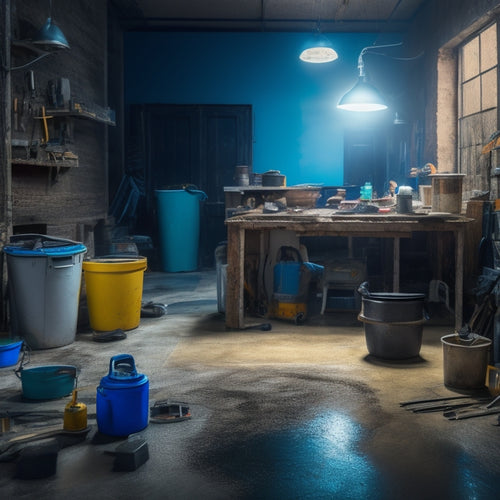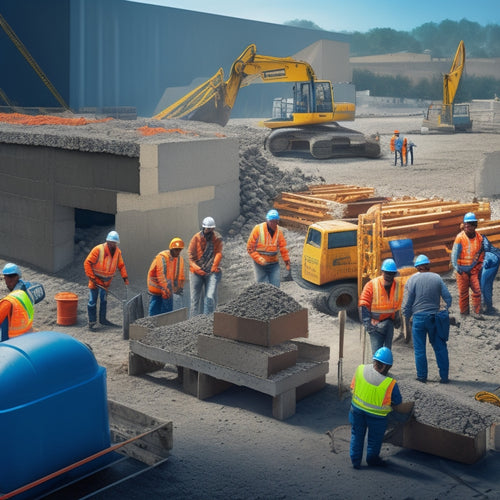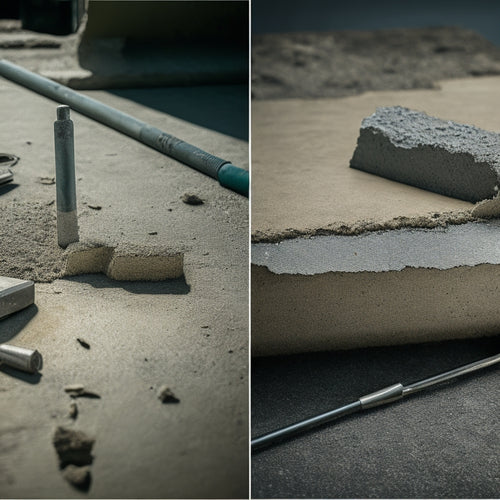
Essential Tools for Concrete Block Construction
Share
You'll need a range of specialized tools to guarantee your concrete block construction project meets professional standards and stands the test of time. Essential tools include a reliable level, sturdy hammer, and tape measure for accurate measurement and block placement. A pointing trowel, block trowel, and jointer/pointing trowel are must-haves for finishing mortar joints. You'll also need leveling and alignment tools like spirit levels and laser levels, as well as tamping tools like handheld tampers and plate compactors. Additionally, concrete block cutting tools, mortar mixing and application tools, and cleaning and finishing tools are all vital for a successful project. As you prepare your toolkit, you'll find that having the right tools at your fingertips can make all the difference in achieving a high-quality finish.
Key Takeaways
• A reliable level, sturdy hammer, and tape measure are essential for accurate measurement and block placement in concrete block construction.
• Leveling and alignment tools like spirit levels, laser levels, and alignment plates ensure precise block alignment and course alignment.
• Tamping tools, including handheld tampers, plate compactors, and jumpers, are necessary for compacting soil and aggregate materials.
• Concrete block cutting tools, such as diamond blade saws, masonry saws, and handheld block cutters, enable precise cuts and adjustments.
• Mortar mixing and application tools, including mixing ratio guidelines, surface preparation, and trowel technique, ensure strong mortar bonds and structural integrity.
Block Wall Construction Tool Requirements
When building a block wall, you'll need a set of essential tools to assure a sturdy and level structure, starting with a reliable level and a sturdy hammer.
These fundamental tools will assure your block wall design meets the required standards for structural integrity. A level will help you maintain precise vertical and horizontal alignments, while a hammer will enable you to tap blocks into place.
Additionally, you'll need a tape measure to accurately measure and mark block positions, as well as a string line to guide your block placement. A mixture of sand, cement, and water will also be necessary for mortar preparation.
Don't forget a pointing trowel for applying and finishing mortar joints. With these tools, you'll be well-equipped to construct a block wall that meets the highest standards of structural integrity.
Essential Tamping Tool Options
As you prepare to lay block after block, you'll need to verify each course is properly compacted, which is where tamping tools come into play, allowing you to remove air pockets and excess mortar.
There are several tamping tool types to choose from, including handheld tampers, plate compactors, and jumpers. Handheld tampers are ideal for small areas and tight spaces, while plate compactors are better suited for larger areas and heavier loads. Jumpers, on the other hand, are designed for compacting soil and aggregate materials.
Regardless of the tamping tool type you choose, regular maintenance is vital to guarantee peak performance. You'll need to clean and lubricate your tamping tool regularly to prevent rust and corrosion.
Additionally, inspect your tool for any signs of wear and tear, and replace worn-out parts promptly. Proper tamping tool maintenance won't only extend the lifespan of your tool but also assure consistent results in your concrete block construction project.
Concrete Block Cutting Essentials
You'll need to precisely cut concrete blocks to fit around corners, doors, and windows, guaranteeing a snug and stable structure. This requires the right tools and techniques, depending on the type of concrete block you're working with. For example, solid concrete blocks require a diamond blade saw or a masonry saw, while hollow blocks can be cut using a carbide-tipped saw blade or a handheld block cutter.
When choosing a cutting technique, consider the desired finish and the block's density. Dry-cutting with a diamond blade saw is ideal for clean, precise cuts, while wet-cutting with a masonry saw reduces dust and heat buildup. For more intricate cuts, use a handheld block cutter or a tile nipper.
Regardless of the technique, always wear protective gear, including safety glasses, gloves, and a dust mask.
Remember to measure carefully and mark the blocks accurately to guarantee a precise fit. With the right tools and techniques, you'll be able to make clean, accurate cuts and achieve a professional-looking finish.
Leveling and Alignment Tools
To guarantee a structurally sound and visually appealing concrete block construction, set the blocks perfectly level and aligned using specialized tools, such as spirit levels, laser levels, and alignment plates. You'll achieve accurate horizontal and vertical alignment with these tools, making sure your structure is plumb and square.
A spirit level provides a simple, yet effective way to check for levelness, while a laser level offers more precision and versatility. For more complex projects, consider using an alignment plate, which serves as a reference point for block placement.
When working with laser levels, you'll appreciate the convenience of a self-leveling feature, which automatically adjusts to the surrounding environment. This feature saves you time and guarantees accurate readings.
Additionally, look for an alignment guide that allows for easy adjustments and fine-tuning. With these tools, you'll be able to achieve precise block alignment, resulting in a strong, durable, and aesthetically pleasing structure.
Mortar Mixing and Application
When it comes to mortar mixing and application, you'll need to get it just right to guarantee a strong and durable concrete block structure.
You'll want to follow established guidelines for mixing ratios, master proper application techniques, and maintain tight control over mortar consistency.
Mixing Ratio Guidelines
Proper mortar mixing and application rely on adhering to specific mixing ratio guidelines to confirm structural integrity and maximum performance in concrete block construction.
You'll need to master the art of mixing mortar to guarantee your concrete blocks hold together securely. To achieve this, you must understand the importance of mixing ratio guidelines.
When it comes to mixing techniques, you'll need to adjust the ratio of cement to sand to water accordingly. A general rule of thumb is to use one part cement to three parts sand, with the right amount of water to achieve a workable consistency.
However, ratio adjustments may be necessary depending on factors such as environmental conditions, type of cement, and desired strength. For instance, in hot and dry climates, you may need to increase the water content to prevent rapid drying. On the other hand, in cold climates, you may need to reduce the water content to prevent excessive shrinkage.
Proper Application Techniques
You'll need to scoop the mixed mortar onto a hawk or a mortar board, holding it at a 45-degree angle to prevent the mixture from dripping off. This allows you to maintain control over the amount of mortar you're applying to the concrete block.
Next, you'll need to prepare the surface of the block by ensuring it's clean, dry, and free of any debris. Proper surface preparation is essential for a strong bond between the mortar and the block.
When applying the mortar, use a trowel to spread it evenly, holding the trowel at a 20-degree angle. Apply the mortar in a circular motion, starting from the center of the block and working your way outwards.
Make sure to fill all the holes and cavities, but avoid overfilling, as this can lead to excess mortar squeezing out during placement.
Mortar Consistency Control
To achieve a strong and durable bond between the concrete block and mortar, it's vital to maintain consistent mortar consistency during mixing and application.
You'll need to control the mortar's workability, which is affected by factors like water content, temperature, and mixing time. Moisture control is important, as excessive water can lead to a weak bond, while insufficient water can cause the mortar to be too stiff.
You can use mortar additives to enhance workability and improve the bond between the concrete block and mortar. These additives can also help you achieve the desired consistency, even in extreme weather conditions.
When mixing, make sure to follow the manufacturer's instructions and use the correct mixing ratio. It's also important to mix the mortar in a clean and well-ventilated area to prevent contamination.
During application, verify the mortar is applied consistently to the block, using the correct trowel size and technique. You should also maintain a consistent joint width and fill the joints fully to achieve the desired bond.
Block Laying and Setting Tools
Lay out a level string line to guide your block laying, guaranteeing accurate course alignment and eliminating the need for constant checking. This guarantees that your block laying techniques are precise and efficient, allowing you to work quickly and confidently.
To achieve setting accuracy, use a spirit level and a straightedge to verify the level and plumb of each course.
You'll also need a block trowel to spread and finish the mortar joints. Choose a trowel with a sturdy handle and a flat, rectangular blade that's perfect for scooping and spreading mortar.
For more precise control, use a jointer or a pointing trowel to finish the joints. Don't forget a level and a string line pins to secure the string line in place.
These tools will help you maintain setting accuracy and guarantee a professional-looking finish. By using these essential tools, you'll be able to lay blocks quickly and accurately, with precision and control.
Cleaning and Finishing Tools
A sturdy wire brush and a soft-bristled broom are essential cleaning tools for removing excess mortar and debris from freshly laid blocks, ensuring a clean surface for finishing. You'll also need a garden hose with a spray nozzle to gently rinse the blocks, removing any remaining dirt or mortar residue. For more thorough cleaning, a pressure washer can be used, but be cautious not to damage the blocks.
When it comes to finishing techniques, a jointer or trowel is necessary for filling and finishing joints between blocks. A pointing trowel is also useful for applying and finishing pointing mortar. Additionally, a level and straightedge will help you achieve precise, straight joints.
To achieve a professional-looking finish, you'll need to master various cleaning methods and finishing techniques. Practice makes perfect, so don't be afraid to experiment with different tools and techniques to find what works best for you. By having the right cleaning and finishing tools on hand, you'll be able to achieve a high-quality finish that will last for years to come.
Safety Equipment and Accessories
When you're working with concrete blocks, you're exposed to hazardous materials and heavy equipment, which makes safety equipment and accessories a must-have.
You'll need to prioritize your well-being by investing in high-quality personal protective gear, including hard hats, gloves, and steel-toed boots.
As you begin constructing, don't forget to add eye and face shields to your arsenal to protect yourself from flying debris and chemical splashes.
Personal Protective Gear
You must wear personal protective gear (PPG) to safeguard yourself from the hazards associated with concrete block construction, including flying debris, chemical exposure, and physical injury. This isn't an optional precaution, but a necessity to guarantee your well-being on site.
When it comes to hand protection, you'll need protective gloves that can withstand the rough handling of concrete blocks and harsh chemicals. Look for gloves with a durable palm material, such as cowhide or synthetic materials, and a reinforced thumb and index finger.
Your feet are also vulnerable to injury, so invest in safety footwear with a sturdy sole and ankle protection. Steel-toed boots or shoes with a slip-resistant sole are essential for preventing foot injuries.
Additionally, consider wearing long-sleeved shirts, long pants, and a hat to protect your skin from cuts and abrasions.
Eye and Face Shields
Shielding your eyes and face from flying debris, chemical splashes, and other hazards is critical in concrete block construction, as even a single incident can cause permanent damage.
As you work with concrete blocks, you're exposed to various risks that can harm your eyes and face. That's why it's important to wear the right eye and face protection gear.
Here are some must-haves for your eye and face protection:
-
Safety glasses: These provide basic eye protection against flying debris and particles. Look for ones with anti-fog coating and scratch-resistant lenses.
-
Face shields: These offer additional protection for your face, especially when working with chemicals or power tools. Choose ones with a clear visor and adjustable headgear.
-
Goggles: These provide more extensive eye protection, especially when working with hazardous materials or in dusty environments.
- Prescription safety glasses: If you wear prescription glasses, don't compromise on eye protection. Get prescription safety glasses that meet ANSI standards for impact resistance.
Frequently Asked Questions
Can I Use a Regular Hammer for Concrete Block Construction?
You're wondering if you can use a regular hammer for concrete block construction. The short answer is no, you shouldn't.
Regular hammers aren't designed to withstand the rigors of concrete block construction. You'll need a hammer specifically designed for masonry work, like a brick hammer or a splitting maul.
These hammers are built with durability in mind, featuring heavy-duty heads and handles that can absorb shock.
Using the right hammer type guarantees your tool lasts longer and you get the job done efficiently.
How Do I Prevent Mortar From Staining My Tools?
You're about to spend an eternity scrubbing away at those stubborn mortar stains if you don't take action! To save yourself from this nightmare, you'll want to employ some serious mortar cleanup techniques.
First, always clean your tools immediately after use.
Next, apply a tool protection method like a silicone-based spray or oil to prevent mortar from bonding to metal.
What Is the Best Way to Store Concrete Blocks On-Site?
When storing concrete blocks on-site, you'll want to prioritize block stacking and site organization.
Start by designating a specific area for block storage, ensuring it's level and dry.
Stack blocks in a stable, interlocking pattern, with each course offset by about 1 inch to prevent water accumulation.
Keep the stacks tidy and organized, labeling each type of block for easy identification.
This approach will save you time and reduce the risk of damage or loss.
Can I Mix Mortar in a Wheelbarrow Instead of a Mixer?
Break out your medieval mortar-mixing skills - but ditch the horse and carriage!
When it comes to mixing mortar, you're wondering if a wheelbarrow can replace a mixer. The answer is yes, but with caution.
While a wheelbarrow offers advantages like portability and ease of cleaning, it's essential to follow proper mortar mixing techniques to guarantee consistency and strength.
Mix in small batches, use the right ratio of cement to sand, and don't overmix - or your medieval masterpiece might crumble!
Do I Need to Cure Concrete Blocks After Laying Them?
You're wondering if you need to cure concrete blocks after laying them. The answer is yes, you do.
Proper curing methods are essential to guarantee the blocks reach their maximum strength. When you don't cure them, block moisture evaporates too quickly, leading to weakened blocks.
You can use methods like spraying water, applying a curing compound, or covering with plastic sheets to retain moisture and promote proper curing.
Conclusion
You've assembled the arsenal of essential tools for concrete block construction, ensuring a sturdy structure that stands the test of time.
From tamping tools that tap into precision, to cutting essentials that carve with care, your toolkit is tailored to tackle any task.
With leveling and alignment tools that laser in on accuracy, and mortar mixing and application that masterfully merge, you're poised to build a concrete block masterpiece that's both beautiful and bulletproof.
Related Posts
-

Essential Tools for Epoxy Concrete Floor Repair
You'll need a thorough arsenal of specialized tools to guarantee a successful epoxy concrete floor repair. Floor prep...
-

7 Best Tools for Concrete Block Construction
You'll need a solid foundation, precise cutting, and seamless finishing to guarantee your concrete block construction...
-

Top Tools for Concrete Adhesion Success
When it comes to concrete adhesion success, you'll need to wield the right tools and techniques to guarantee a strong...


